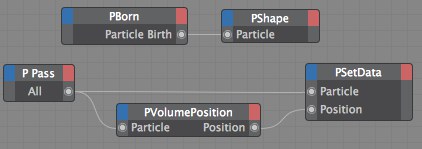Parameter
Choose the object and whether the particles should be emitted from the inside or outside of the object.
Drag & drop the name of the desired polygon object into this box.
Use Type to choose whether the positions should be generated inside or outside the object (Type set to Inside or Outside respectively). You can restrict the effect to a frozen selection. Enter the name of the Selection tag into the Selection box. For details on frozen selections, look up the Set Selection command in the Cinema 4D reference manual.
This value controls the distance from the object’s surfaces at which positions can still be calculated. This enables positions to be calculated for open surfaces such as a polygon plane.
 In contrast to the PSurfacePosition example, we are now generating small, sphere-shaped particles within the volume of the larger sphere. Remember to use a Particle Geometry object to hold the smaller particle spheres and to set the Bounding Radius of the PShape node to a sensible value in relation to the size of the particle spheres.
In contrast to the PSurfacePosition example, we are now generating small, sphere-shaped particles within the volume of the larger sphere. Remember to use a Particle Geometry object to hold the smaller particle spheres and to set the Bounding Radius of the PShape node to a sensible value in relation to the size of the particle spheres.Connect this port to the stream of particles that should be emitted from inside or outside the object, such as to the Particle output port of a PPass node.
Since the node’s parameters can be keyframe animated, by default the Cinema 4D time is used internally to ensure that the values are interpolated correctly. However, you can pass your own time value to this port. This should be of the data type Time, which is a Real number in the simplest case. If no value is passed, Cinema 4D’s time is used.
Outputs the random positions inside or outside the object. You can assign these values to particles by connecting this port to the Position port of a PSetData node.
Outputs the Normals of the random positions. Using this information, you can set the velocity of each particle in such a way that the particles move perpendicularly to the surface.
Outputs the current alignment of the particles, as vectors.